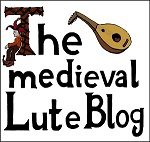Since the late medieval period, music had progressed more and more, which ultimately resulted in a chord – dominated style, as can be found in the Renaissance lute. Therefore, I support the estimation, that lutenists of the late Middle Ages must already have experimented with plucking techniques to some degree, much rather than just using the quill all the time.
This means at some point in polyphonic music (definately in the Ars nova!) they must have started this very shift from single-string and double-string-based melodies to triads to accompany a singer (maybe even themselves), or a musical group.
Chords on the medieval lute sound pretty nice and there are some examples in the web (like from Simone Sorini) where he plays triad chords to assemble a choir, e.g. Another well known medieval lute player using chords is Pepe Frana.
To make a long story short: The G – tuning even very much facilitates playing chords, which could be another good indicator. If you analyze the structure of the strings just as they are set, the strings and the fretboard become very easy to learn and keep in mind (a feature that comes in very useful in a mostly scripture-lacking culture). You got two courses in D, two in G and one in A in the middle. If you then look at the chord-figures in the tabs themselves, you can see a very consistent and well-recognizable pattern there. To me personally, this looks even simpler than basic chords on the modern guitar.
The advantages are at hand – you are no longer reduced to notes and tablature and your inventory on the medieval lute increases somewhat quickly. You can check out any medieval song, hear the chords out, write them above the text and voilá you got an entire new song you can play!
You can derive all other chord-types (diminished, dominant, augmented etc.) from this base:
Major chords
G-major
g—–0——
d—–0——
A—–2——
G—–0——
D—–0——
G#/Ab-major
g—–x——
d—–1——
A—–3——
G—–1——
D—–x——
A-major
g—–x——
d—–2——
A—–4——
G—–2——
D—–x——
Bb/A# major
g—–x——
d—–3——
A—–5——
G—–3——
D—–x——
B-major
g—–x——
d—–4——
A—–6——
G—–4——
D—–x——
C-major
g—–0——
d—–2——
A—–3——
G—–x——
D—–x——
C#/Db-major
g—–1——
d—–3——
A—–4——
G—–x——
D—–x——
D-major
g—–2——
d—–4——
A—–5——
G—–x——
D—–x——
D#/Eb-major
g—–3——
d—–5——
A—–6——
G—–x——
D—–x——
E-major
g————
d—-(2)—–
A—–2——
G—–1——
D—–2——
F-major
g—–x——
d—–x——
A—–3——
G—–2——
D—–3——
F#/Gb-major
g—–x——
d—–x——
A—–4——
G—–3——
D—–4——
Minor chords
G-minor
g—–0——
d—–0——
A—–1——
G—–0——
D—–0——
G#/Ab-minor
g—–x——
d—–1——
A—–2——
G—–1——
D—–x——
A-minor
g—–x——
d—–2——
A—–3——
G—–2——
D—–0——
Bb/A# minor
g—–x——
d—–3——
A—–4——
G—–3——
D—–x——
B-minor
g—–x——
d—–4——
A—–5——
G—–4——
D—–x——
C-minor
g—–0——
d—–1——
A—–3——
G—–x——
D—–x——
C#/Db-minor
g—–1——
d—–2——
A—–4——
G—–x——
D—–x——
D-minor
g—–2——
d—–3——
A—–5——
G—–x——
D—–x——
D#/Eb-minor
g—–3——
d—–4——
A—–6——
G—–x——
D—–x——
E-minor
g————
d—-(2)—–
A—–2——
G—–0——
D—–2——
F-minor
g—–x——
d—–x——
A—–3——
G—–1——
D—–3——
F#/Gb-minor
g—–x——
d—–x——
A—–4——
G—–2——
D—–4——
Here you can download the Basic Chord Scheme of the 5-course medieval lute in G-tuning:
Also, let’s not forget about our friends playing the medieval four-course lute:
